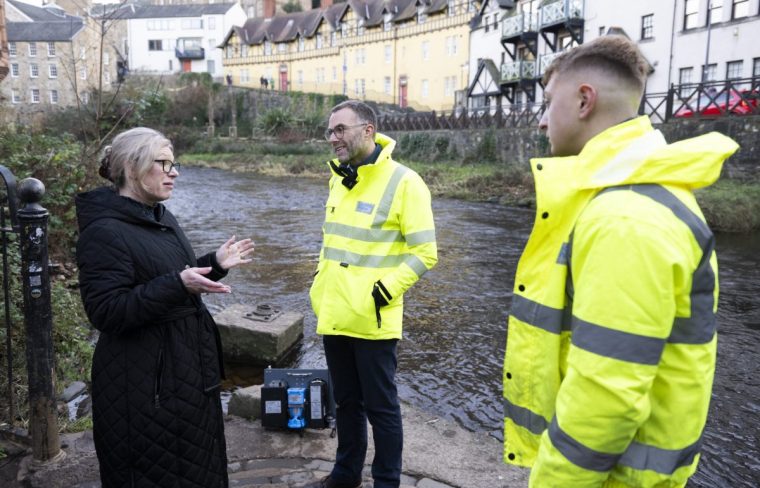Scotland is “lagging behind” England on the monitoring of sewage spills, say campaigners calling on the Scottish Government to get tough with the nation’s water giant.
New figures shared with The i Paper reveal that only 31 per cent of sewage overflow points – around one in three – are being monitored by Scottish Water.
More than 2,800 sites where sewage is released into rivers, lochs and beaches are still unchecked by the country’s publicly-owned water company.
Environmentalists called on the SNP administration to make it mandatory for every single sewage release in Scotland to be monitored.
They argue that it is impossible to understand the scale of the sewage problem without more information – comparing the current situation to a dentist looking at “only one-third of our teeth”.
As highlighted by The i Paper’s Save Britain’s Rivers campaign, there is growing public anger that water companies are legally allowed to discharge sewage via “combined sewer overflows” (CSOs) during periods of heavy rain.
These sewage releases allow condoms, wet wipes and other toilet debris to spill into the nation’s waterways.
Campaigners point to progress in England, where 100 per cent of overflows on the sewer network have now been fitted with event duration monitors (EDMs), which at least provide clear data on sewage releases. In Wales, 99.5 per cent of overflows are monitored.
Scottish Water, which covers the entire country, announced earlier this week that it had fulfilled its promise to install 1,000 new sewer monitors by the end of 2024.
However, figures obtained by the Scottish Liberal Democrats through a freedom of information request show there are still thousands of spill points where sewage releases are going unrecorded.
There are 4,083 sewage overflow points on Scotland’s waterways, and only 267 had been monitored.
Adding 1,000 extra monitors still leaves 2,807 overflow points unmonitored. It means only 31.3 per cent of sewage release sites are monitored.
Lib Dem leader Alex Cole-Hamilton said Scotland had “a grim secret sewage problem”, having called on the SNP Government to “massively ramp up monitoring of sewage dumping”.
He added: “It is welcome that progress is belatedly being made, however, much more needs to be done to get to grips with the problem because we are still leagues behind England where 100% of overflows are monitored.”

The Environment Rights Centre for Scotland (ERCS) called on the Scottish Government to make it mandatory for every sewage overflow to be monitored.
An ERCS spokesperson said “comprehensive” surveillance system was “critical to tackling sewage pollution and protecting the health of residents who currently in most cases are not informed when sewage is discharged to their local river or beach”.
They added: “New monitors are welcome progress from Scottish Water, but monitoring should be made a legal requirement for all sewer overflows to ensure that Scotland reaches the 100 per cent verage that England already has.”
Dr Jim Jarvie, a campaigner with Edinburgh anti-pollution group SOS Leith, said he had been shocked to find that there was no data for sewage spills at 67 CSOs along the Water of Leith river in Scotland’s capital.
Monitors at all 67 CSOs along the Water of Leith have now been installed, said Scottish Water – promising overflow data soon. But Dr Jarvie is dismayed that sewage releases at thousands of sites across Scotland remain a mystery.
“It’s like going to a dentist and getting only one-third of our teeth looked at,” he said. “If we are not looking at all the CSOs, we still don’t know what is coming out of the sewer network, in what volume and when it is happening.”
He added: “The monitoring is only one part of the problem. We also need to see proper testing of the water, and significant investment in [sewer network] upgrades.”
Kathleen Edie, of the River Almond Action Group, said it was “positive” that the number of outflows monitored had expanded with Scottish Water’s investment programme.
“However, we still lag far behind monitoring by in England,” she added. “Even with the increase in monitoring the picture is incomplete and reflect that communities do not have enough information on the state of our water bodies.”
Scottish Water has promised to install another 700 sewer monitors by the end of 2025. The water company has also promised to produce an online overflow map showing near real-time data on what is happening with sewage releases across the country.
A Scottish Water spokesperson said: “The 1,000 new monitors we’ve installed on overflows this year – taking our monitoring coverage to over 30 per cent – will give us unprecedented levels of intelligence about how overflows are performing and these, plus another 700 monitors to be installed next year, will help us make further improvements.”
They said Scotland had fewer monitors than England and Wales because of “strategic decisions” to target the areas of greatest risk to the environment “rather than the more blanket approach to monitor installation adopted in the rest of Britain”.
“Whilst we are not complacent and want to see this improve further, aiming for 100 per cent monitoring of our waterways will not improve their quality as a standalone measure,” the SNP minister said.
“Instead Scottish Water has carried out a comprehensive environmental study on water quality, so that it can prioritise investment according to the locations most in need. This is the correct approach given so many of our waterways are already in good condition.”


